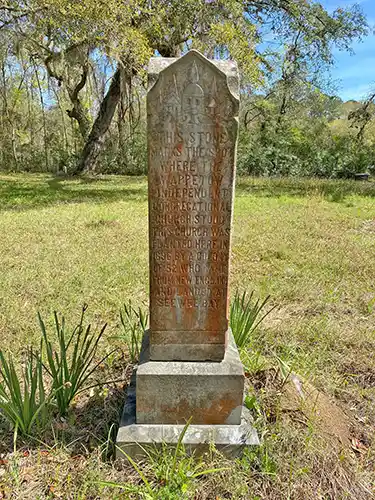 With many historic churches dotting the skyline, Charleston is often called the Holy City. People forget that there is a good share of picturesque old churches on the other side of the Ravenel Bridge as well: St. Andrew’s, Christ Church, St. Paul’s, Friendship AME, Mount Pleasant Presbyterian and more. But where was the very first place of worship east of the Cooper? The answer lies in an area the Sewee tribe called Wappetaw, meaning “sweet water.”
With many historic churches dotting the skyline, Charleston is often called the Holy City. People forget that there is a good share of picturesque old churches on the other side of the Ravenel Bridge as well: St. Andrew’s, Christ Church, St. Paul’s, Friendship AME, Mount Pleasant Presbyterian and more. But where was the very first place of worship east of the Cooper? The answer lies in an area the Sewee tribe called Wappetaw, meaning “sweet water.”
In 1696, a ship carrying 52 New Englanders arrived on the shores of Sewee Bay. These immigrants from Ipswich, Massachusetts, were known as dissenters because they did not follow the doctrine of the Church of England. The group was comprised not only of Congregationalists but also of Huguenots, or French Protestants, and Presbyterians. In those days, all of South Carolina was under the Anglican church’s authority. However, dissenters were granted religious tolerance here, a practice that many of the 13 original colonies did not follow. Ironically, several of South Carolina’s early governors were dissenters, one of whom invited the new settlers to the area.
Other Congregationalists had arrived a bit earlier in what is now Summerville and in downtown Charleston, establishing places of worship there. These later arrivals established Wappetaw Independent Congregational Church on what is now 15 Mile Landing Road in Awendaw. The population grew quickly, and an additional Congregationalist meeting house was soon established nearby on the Cainhoy peninsula.
Unlike the affluent planter class who were mostly members of the Anglican Church, these settlers were yeoman families, working the land themselves rather than relying on enslaved laborers. Their enterprises were not on the grand scale of the rice and indigo plantations, but these new members of the community provided important agricultural products to local residents.
They were also enthusiastically invested in the safety and establishment of the colony. When French and Spanish forces threatened Charles Town in 1706, men from Wappetaw’s “country company” of volunteer militia engaged them in battle near Bulls Bay, killing a dozen men and capturing 50 others.
Decades later, during the Revolutionary War, the Wappetaw Church was seized by British troops who used it as a command post. Tradition holds that British Colonel “Bloody Tarleton” burned the structure when his troops positioned there were surrounded by patriot militia. This event was loosely depicted in Mel Gibson’s movie, “The Patriot.” Although the film may have taken liberties with many historical facts, the British did indeed destroy the building, along with all church records. Shortly after the war’s end, church members rebuilt it as a large wooden structure with a double front door and two side doors leading to the upstairs galleries. The Civil War took its toll on that structure over 80 years later, when Union forces tore out the wooden pews and flooring to burn as firewood, rendering the building unusable. The church deteriorated over time and disappeared by 1897. By then, many of its former members had established Mount Pleasant Presbyterian Church in Mount Pleasant’s Old Village and Wappetaw Presbyterian Church in McClellanville.
Today, remnants of the church are nearly gone, but not forgotten. All that remains, most fittingly, is the church’s graveyard nestled on a 1.4-acre lot populated with centuries-old live oak trees.

Leave a Reply